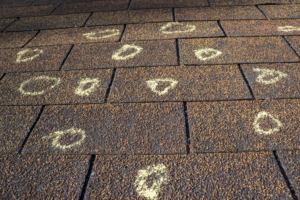Analyzing Hail Damage: A Forensic Engineer’s Approach to Inspecting Hail Damage
by Kevin Gallagher
Here at Forte, we have recently noticed a rise in our hail/storm damage investigations, outside of the normal “hail belt” states, (Texas, Colorado, Nebraska, Kansas, Oklahoma, Florida, and Wyoming). We are seeing an increase in hail investigation requests out of the Northeast and other parts of the Mid-West, as storm chasers and contractors are going door to door in all areas affected, and unaffected by major storms involving hail.
When it comes to assessing hail damage, Forte plays a crucial role in providing unbiased expert analysis. Our experts’ specialized knowledge and meticulous examination techniques enable us to accurately evaluate the extent of hail damage. We can also determine whether damage even exists and what other causes of damage are evident, other than hail, with a special eye on damages fraudulently created by the roofer/contractor. Additionally, with sufficient evidence, we can determine if the hail damage is related to a specific storm event. Our goal is to help our clients make informed decisions and to be cognizant of hail claim fraud tactics, and roofing scams.
Here are some statistics/information:
- In 2022, there were reportedly 4,436 hail events in the USA. *
- 16% of all homeowners’ claims in the U.S. are hail related. *
- 20% of homeowner claims costs in the U.S. are hail related. *
- The number of hail claims reported in America increased by over 17% from 2021 – 2022
- In 2022 State Farm alone paid $3.5B in hail claims, an increase of $1 Billion over the previous year.***
- In 2023, the average cost of a roof repair from hail damage is $4,250, and in more serious situations can be as high as $32,500. **
*** https://www.iii.org/fact-statistic/facts-statistics-hail
Visual Examination
Our experts begin by conducting a detailed visual examination of the property, focusing on the area’s most vulnerable to hail damage, for example, the roof, soft metals on the roof such as vents, gutters, siding, windows, downspouts, and exterior surfaces. They look for visible signs of impact, including dents, cracks, fractures, or other surface deformations. Precise documentation of all observations is crucial, including photographs and videos that serve as evidence during the claims process.
Shingle Assessment
For roof inspections, our experts pay particular attention to shingles, as they are often the most affected by hail damage. They assess the shingles for signs of bruising, fractures, or missing granules caused by hail impact. They also evaluate the integrity of the roof’s shingle’s shedding capabilities, checking for cracks or exposed underlying layers.
Underlying Structure
The inspection process extends beyond the visible components. If necessary, our experts carefully evaluate the underlying structure, including the roof deck, sheathing, and attic, to detect any hidden damage caused by the hailstorm. They examine for signs of water infiltration, weakened structural elements, or compromised insulation.
Documentation and Reporting
Our experts then prepare comprehensive reports detailing their findings, including descriptions of observed damage, photographic evidence, weather/CoreLogic reports, and analytical results. These reports serve as crucial documentation for our clients, providing objective and expert opinions regarding the extent of hail damage.
All the above was confirmed while speaking with a structural engineer out of the state of Florida, Charles Long. He said:
“There are a few critical things I generally look for when inspecting a property that has suffered from hail damage, and these items can be applied regardless of the roof’s finish (tile/shingle).
Damage is generally presented from a single direction. It is highly uncommon for a structure to suffer damage on each elevation. Damage on multiple slopes/elevations indicates damage from multiple storm events. Also, inspection of miscellaneous metals helps a great deal. Gutters, downspouts, aluminum framing, roof vents, mailboxes, etc. help to confirm the presence of hail damage (dents/dings in the metal surface).
The field data/observations are then compared to weather data (CoreLogic/Weather Underground) to verify the storm event at the loss location.”
In Conclusion:
As we progress in the examination of these hail-damaged structures (both residential and commercial,) we will continue to provide updates and information to better understand our findings. I have come to notice some interesting trends regarding assignment clusters, damage radius, and more.
In the meantime, feel free to reach out to talk about hail damage and if you would like to assign a hail damage claim to Forte for a consultant inspection, you can do so by clicking here.




